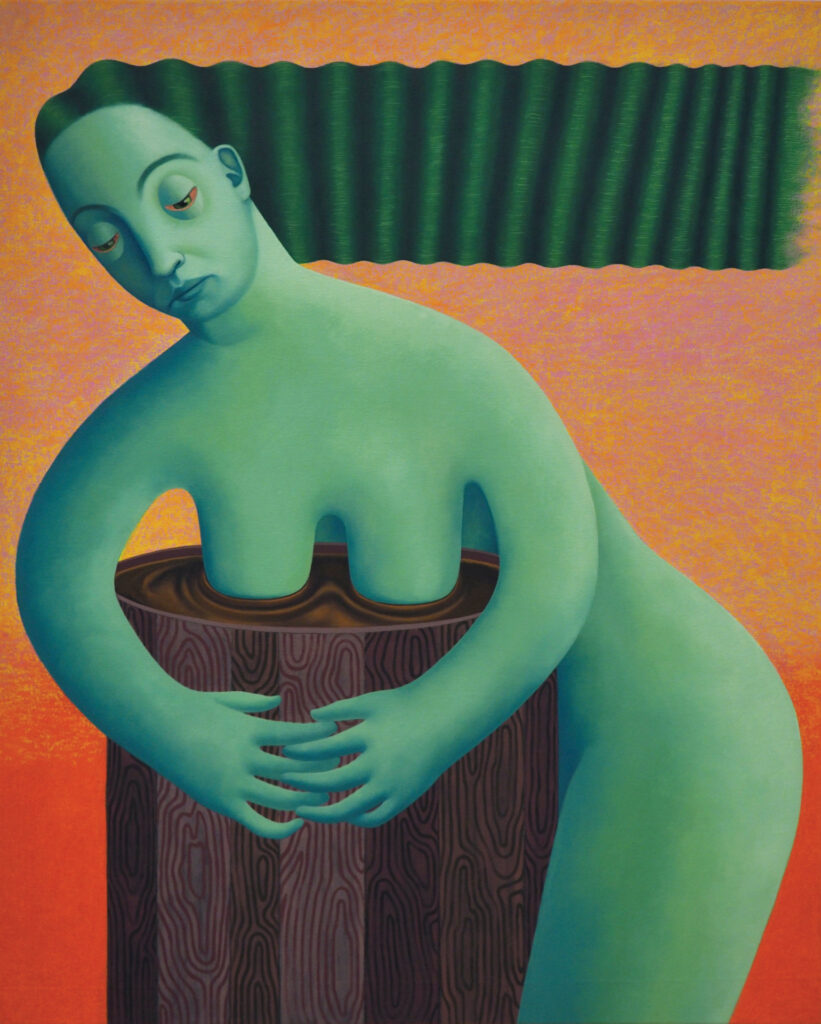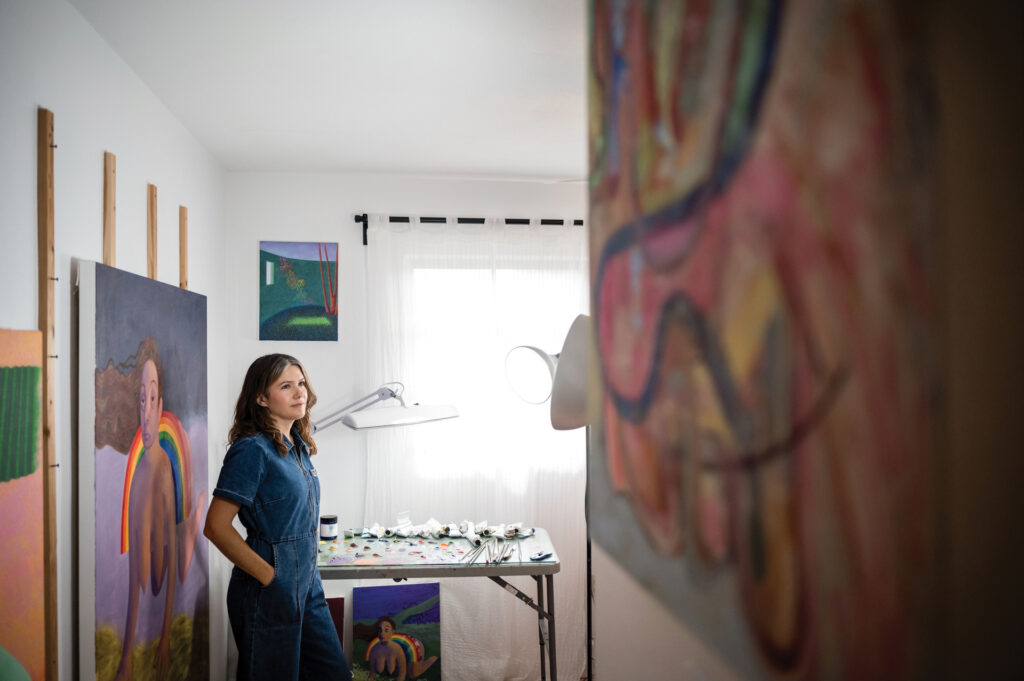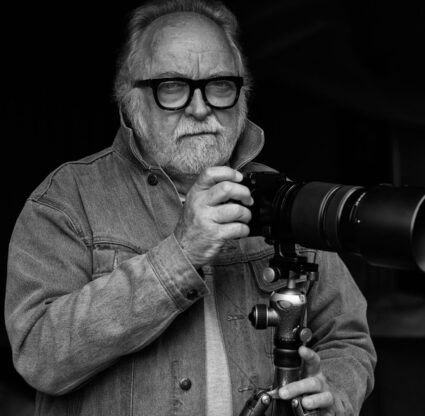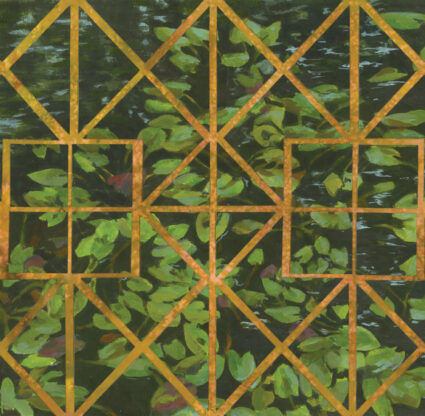Even before she became a mother, Fort Myers-based painter Grace Mikell Ramsey was captivated by the strength of women. “I’m interested in the rituals and experiences of being human, and the most magical are female,” she says. “Giving birth was the most empowering experience, getting to be part of the flow of history.” But motherhood was not without its challenges. When her daughter, Marigold, was born in 2017, Grace embraced the attachment parenting style and breastfed her for three and a half years. The closeness between mother and daughter was precious but overwhelming.
When Marigold was a few months old, Grace visited New Orleans, where she had earned a master of fine arts degree at Tulane University in the early 2010s. She asked some friends if they would be open to undressing for a photoshoot. Together, the women tried different poses, chatting about the unique demands of motherhood until one suggested they nurse each other. While Grace would often transpose photographs into a single composition, she only used a single image from this shoot. She loved the powerful message it evoked. In the finished painting, Latch (2019), women are realistically depicted with their bodies tangled on a rug, their skin cast in a greenish pall. The artwork points to the dissolution of selfhood involved in raising another human being and the essential bonds formed between female friends, especially mothers. “It just poured out of me,” Grace recalls. “It has a lot to do with the complexities of nurturing, what it looks like to give and give and give.”
The layered relationships between women have long influenced her work, in which photorealist figures are immersed in surreal, dreamlike landscapes. “I realized early on that I was interested in drawing and painting people,” Grace says. “But I also liked the idea that I could make a narrative painting. There’s something about the surreal language of dreams that is uncanny.”
As a teen, Grace took private art lessons from a woman in her small town. Rooted in fundamentals, the instructor had her spend an entire year drawing before Grace was even allowed to touch a paintbrush. During college, she pursued religious studies instead of art. Along the way, friends persuaded her to sign up for a drawing class. “That really changed everything,” Grace recalls. “It wasn’t just about how accurately you could draw from life.” Her professor unlocked the door for Grace to express herself, and her talent took flight. Later, while pursuing a master of fine arts, she began experimenting with more expressive styles.
Keep (2011), painted while Grace was at Tulane, shows three young women pricking their fingers with needles, as if about to swear a blood oath. In Feeding (2014), another sinister early painting, a woman solemnly presents her severed breast on a plate to a toddler, who greedily grasps a fork and steak knife. The macabre portrait is inspired by Saint Agatha, the Sicilian martyr and patron saint of breast cancer. Grace often draws from Old World Renaissance and Flemish primitive artists and their depictions of religious martyrdom. But Grace isn’t mired in darkness. “Riding that line between beauty and grotesque—I think it can be more impactful,” she says. She laughs often and is quick to acknowledge the joys of parenthood. Daughter (2020) embodies her sunnier outlook. Marigold’s face gazes skyward, enveloped in a cozy swirl of fabric, while rainbow-hued squirrels leap through the twilight sky. It is magical and innocent; it might almost have been made just to delight her little girl.

Before motherhood, Grace would photograph subjects and do multiple sketches of the composition prior to creating a smaller study using acrylics to solidify the color palette and placement. The finished sketch was then photographed, digitally projected onto a bigger canvas and traced. “At that moment, I know a lot of what it’s going to look like, but I haven’t taken the study so far that I know every detail,” she says. As a new mom juggling a career as an assistant professor at Florida Gulf Coast University, making such laborious paintings became untenable.
In the precious few hours after Marigold and later her son, Cosmo, went to sleep, Grace would slip away to her home studio to paint. She began experimenting with creating imagined figures that function as symbolic representations. “I’ve adapted more of an intuitive approach,” Grace says. “It’s really fun to make a figure that I have in my head and put more of my energy into having a certain feeling instead of making it look a certain way.”
Her latest works, like God Only Knows (2022), still capture the psychological strangeness of her earlier paintings. A woman with green skin, her expression grave and tired, dips her breasts into a wooden barrel of brown liquid. In contrast to the weariness, the sky is golden and the woman radiates, her hair flowing behind her in lustrous waves. The juxtaposition combines the contradictions of motherhood, creating a perfect representation of how parenting feels much of the time. “The paintings I’m working on now feature a single woman going through some trial or tribulation,” Grace says. “I’m not interested in making paintings that are just saccharine or pretty. I believe in being honest, genuine and open. That’s the full scope of being a person.”





